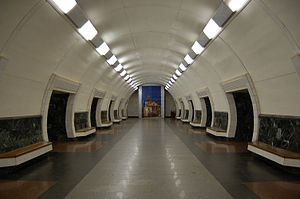- Dorohozhychi (Kiev Metro)
-
Dorohozhychi
Kiev Metro station
Station HallStation statistics Coordinates 50°28′25″N 30°26′57″E / 50.47361°N 30.44917°ECoordinates: 50°28′25″N 30°26′57″E / 50.47361°N 30.44917°E Lines  Syretsko-Pecherska Line
Syretsko-Pecherska LineStructure underground Levels 1 Platforms 1 Tracks 2 Other information Opened 2000-03-30 Electrified Yes Owned by Kiev Metro Services Preceding station Kiev Metro Following station TerminusSyretsko-Pecherska Line toward Chervony KhutirDorohozhychi (Ukrainian: Дорогожичi) is a Kiev Metro station on the Syretsko-Pecherska Line. Opened on 30 March 2000, the station represents the second extension of the Syretsky radius to the northwest.
The station, desined by architects V. Gnevyshev, N.Aloshkin and T.Tselikovska presents itself as a deep-level pylon trivault. In the design, the shape of the vaults is made dominant, by continuing their curvature all the way to the floor level. This makes the overall appearance of the station lacking pylons, but instead there are even, geometric openings which offer passageways to the adjacent platform vaults. The portals of the openings are punctuated with indents that run along their edges. The station contains a rich combination of decorative materials. Green marble is used for the sides of the passageways, and the lower part of the pylons. White marble is used for the station walls and indents along the portal edges. The ceilings are made from aluminium planes that run perpendicular to the platform length. Lighting comes from a single (platform halls) or double (central) rows of continuous fluorescent elements that are neatly covered by plastic. Floor is riveted with red granite on the platforms and grey granite in the centre of the central hall. In the back end of the station, is a decorative image of a church in a Ukrainian Baroque style. Dorohozhychi is one of the last stations to be built in what is known as the rich post-Soviet decoration. This was done deliberately to mark the transition of the Kiev Metro into the 21st century, as the large use of marble, wooden benches and the large empty space were all considered to be archaic for contemporary station design. All subsequent stations turned to more aesthetic high-tech themes.
The station has one underground vestibule which is located in the middle of the Syrets district on the intersection of the Schusev and Teliha streets. During daytime, two glazed domes, provide daylight inside. There are additional escalators between the vestibule and the street level. During the construction of the extension from Lukianivska a provision for another station, Vulytsa Hertsyna was left for further completion.
External links
- (Ukrainian) Kyivsky Metropoliten - Station description and Photographs
- (Russian) Metropoliten.kiev.ua - Station description and Photographs
- (Czech) Zarohem.cz - Photographs
- (Russian) Skorostnoy Tramvay - Photographs
Kiev Metro Sviatoshynsko-Brovarska Line
 Akademmistechko • Zhytomyrska • Sviatoshyn • Nyvky • Beresteiska • Shuliavska • Politekhnichnyi Instytut • Vokzalna • Universytet • Teatralna
Akademmistechko • Zhytomyrska • Sviatoshyn • Nyvky • Beresteiska • Shuliavska • Politekhnichnyi Instytut • Vokzalna • Universytet • Teatralna • Khreshchatyk
• Khreshchatyk  • Arsenalna • Dnipro • Hidropark • Livoberezhna • Darnytsia • Chernihivska • Lisova
• Arsenalna • Dnipro • Hidropark • Livoberezhna • Darnytsia • Chernihivska • Lisova
Kurenivsko-Chervonoarmiyska Line
 Heroiv Dnipra • Minska • Obolon • Petrivka • Tarasa Shevchenka • Kontraktova Ploshcha • Poshtova Ploshcha • Maidan Nezalezhnosti
Heroiv Dnipra • Minska • Obolon • Petrivka • Tarasa Shevchenka • Kontraktova Ploshcha • Poshtova Ploshcha • Maidan Nezalezhnosti • Ploshcha Lva Tolstoho
• Ploshcha Lva Tolstoho  • Olimpiiska • Palats "Ukrayina" • Lybidska • Demiivska • Holosiivska • Vasylkivska • Vystavkovyi Tsentr • Ipodrom • Teremky
• Olimpiiska • Palats "Ukrayina" • Lybidska • Demiivska • Holosiivska • Vasylkivska • Vystavkovyi Tsentr • Ipodrom • TeremkySyretsko-Pecherska Line
 Syrets • Dorohozhychi • Lukianivska • Lvivska Brama • Zoloti Vorota
Syrets • Dorohozhychi • Lukianivska • Lvivska Brama • Zoloti Vorota • Palats Sportu
• Palats Sportu  • Klovska • Pecherska • Druzhby Narodiv • Vydubychi • Slavutych • Osokorky • Pozniaky • Kharkivska • Vyrlytsia • Boryspilska • Chervony KhutirFuture lines:
• Klovska • Pecherska • Druzhby Narodiv • Vydubychi • Slavutych • Osokorky • Pozniaky • Kharkivska • Vyrlytsia • Boryspilska • Chervony KhutirFuture lines: Podilsko-Vyhurivska Line (under construction) •
Podilsko-Vyhurivska Line (under construction) •  Livoberezhna Line (proposed) • Metro Bridge • Pivdennyi Bridge • List of stationsCategories:
Livoberezhna Line (proposed) • Metro Bridge • Pivdennyi Bridge • List of stationsCategories:- Kiev Metro stations
- Railway stations opened in 2000
Wikimedia Foundation. 2010.




